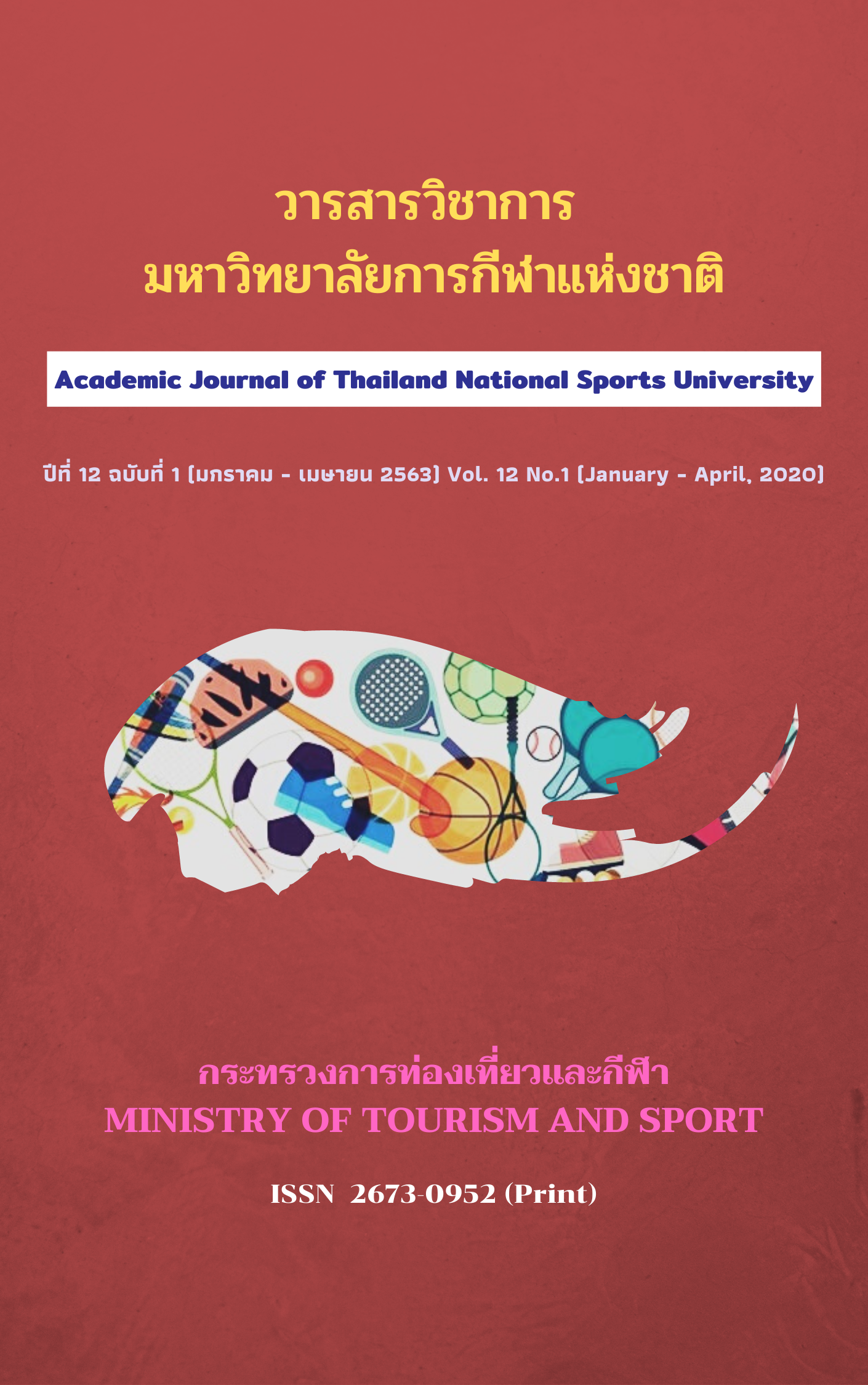STRUCTURAL EQUATION MODEL OF EFFECTIVE FITNESS CENTERS IN BANGKOK METROPOLITAN AND VICINITY REGION
Main Article Content
Abstract
The major objective of this research was to analyze a structural equation model of effective fitness center managerial factors in Bangkok metropolitan and vicinity region based on Competing Value Approach (CVA) theory. Samples were 660 stakeholders of Fitness First, We Fitness, and Virgin Active. Instrument was questionnaire adopted from Dittachai Chankuna (2018). Statistics used was structural equation modeling by Mplus software. The results were found that a structural equation model of effective fitness center in Bangkok metropolitan region composed of exogenous latent variable named Means and endogenous latent variable named Ends, with moderate fit (CFI = 0.856). Means represented Planning and Organizing, Consumer Behavior, Consumer Relation, and Human Resource Management. Ends represented Service and Product, Marketing Strategy, Organization Development, and Career Path. Means had a direct effect to Ends at a moderate level (Path Coefficient = 0.865). Consumer behavior and Marketing Strategy strongly affected to manage fitness center for effectiveness (Factor Loading = 0.844 and 0.881 respectively).
Article Details
The published article is a copyright of the Academic Journal of Thailand National Sports University. The passage appeared in each article in this academic journal is a perspective of each author which is not related to the journal. Each author is required to be responsible for all components of his/her own article. If there are any mistakes, each author must be responsible for those mistakes on his/her own.
References
Bandalos, D. L. (2002). The effects of item parceling on goodness-of-fit and parameter estimate bias in structural equation modeling. Structural equation modeling: A Multidisciplinary Journal, 9(1), 78-102.
Barth, M., Emrich, E., & Daumann, F. (2018). Approaches and methods used for measuring organizational performance in national sport governing bodies from 1986 to 2014. A systematized review. Current Issues in Sport Science, 3(010), 1-22.
Bodin Jaroenpradabkul & Pakdee Manahiranwed. (2016). Factors that influence a customer’s behavior toward decision-making in selection of the gym in Bangkok: Case study fitness first. Journal of Rangsit Graduate Studies in Business and Social Science, 1(1), 104-117.
Cameron, K. & Whetten, D. A. (1983). Organizational effectiveness: A comparison of multiple models. New York, NY: Academic Press.
Cameron, K. (1978). Measuring organizational effectiveness in institutions of higher education. Administrative Science Quarterly, 23(2), 604-627.
Chelladurai, P. (1987). Multidimensionality and multiple perspectives of organizational effectiveness. Journal of Sport Management, 1(1), 37-47.
DiPadova, L. M. & Faerman, S. R. (1993). Using the competing values framework for management information systems. Human Resource Management, 32(3), 175-202.
Dittachai Chankuna. (2014). Operationalization of the competing value approach for developing sports organizational effectiveness in Thailand. Journal of Sports Science and Technology, 14(1), 113-130.
Dittachai Chankuna. (2018). Confirmatory Factor analysis of effective fitness centers in Bangkok metropolitan region. Academic Journal Institute of Physical Education, 10(1): 65-76.
Dittachai Chankuna and Thanatpong Sukwong. (2018). 8Ps Marketing Mix Strategy in Fitness Business. Science Journal Chandrakasem Rajabhat University, 28(3), 37-44.
Eydi, H., Ramezanineghad, R., Yousefi, B., Sajjadi, S. N., & Malekakhlagh, E. (2011). Compressive review of organizational effectiveness in sport. Sport Management International Journal, 7(1), 6-21.
Hu, L.-t., & Bentler, P. M. (1998). Fit indices in covariance structure modeling: Sensitivity to underparameterized model misspecification. Psychological Methods, 3(4), 424-453.
Hu, L.-t., & Bentler, P. M. (1999). Cutoff criteria for fit indices in covariance structure analysis: Conventional criteria versus new alternatives. Structural Equation Modeling, 6(3), 1-55.
Ibrahim, A., Hamatineghad, M., Ramezanineghad, R., & Eydi, H. (2013). Designing organizational effectiveness model of selected iraq’s sport federations based on competing values framework. Sport Management International Journal, 9(1), 69-85.
Jekauc, D. et al. (2015). Prediction of attendance at fitness center: a comparison between the theory of planned behavior, the social cognitive theory, and physical activity maintenance theory. Frontiers in Psychology, 6(1), 1-10.
Karteroliotis, K. & Papadimitriou, D. (2004). Confirmatory factor analysis of the sport organizational effectiveness scale. Psychological Reports, 95(2), 366-370.
Kiattirat Warinsirirak & Suwalee Kaewloka. (2013). Marketing of fitness center in Thailand. Journal of Sport Management Association of Thailand, 3(2), 31-39.
Kline, R. B. (2015). Principles and practice of structural equation modeling. (4th ed.). New York, NY: The Guilford Press.
Papadimitriou, D. & Taylor, P. (2000). Organizational effectiveness of hellenic national sports organizations: A multiple constituency approach. Sport Management Review, 3(2), 23-46.
Quinn, R. E. & Rohrbaugh, J. (1981). A competing values approach to organizational effectiveness. Public Productivity Review, 5(2), 122-140.
Quinn, R. E. & Rohrbaugh, J. (1983). A spatial model of effectiveness criteria: Towards a competing values approach to organizational analysis. Management Science, 29(3), 363-377.
Rojas, R. R. (2000). A review of models for measuring organizational effectiveness among pro - profit and nonprofit organizations. Nonprofit Management & Leadership, 11(1), 97-104.
Shilbury, D. & Moore, K. A. (2006). A study of organizational effectiveness for national olympic sporting organizations. Nonprofit and Voluntary Sector Quarterly, 35(1),5-38.
Wita Budsdee & Akara Akarajirayuti. (2013). Weight loss fitness marketing activities. Journal of Sport Management Association of Thailand, 3(2), 1-9.


